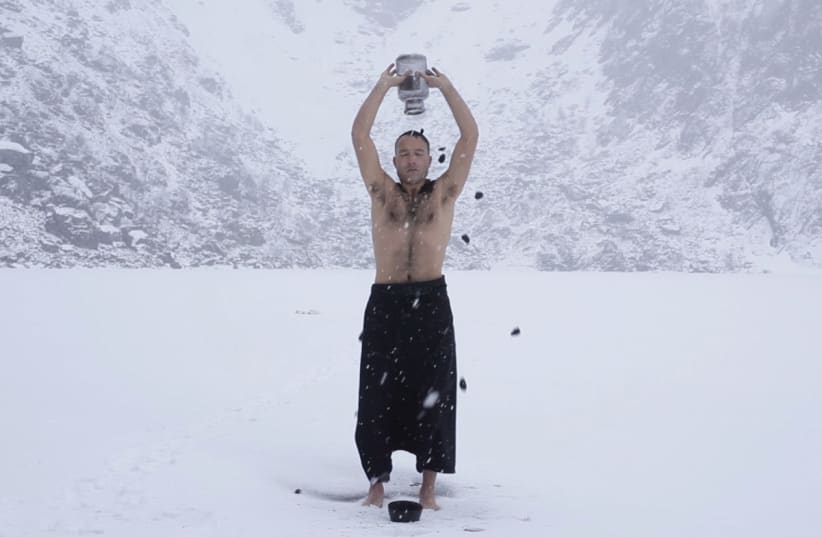“I shot the video in a hall used to screen movies and, since the local church burned down, this is also where they worship,” he told me. “When the Second World War ended, a local man climbed to the top of the mountain and tore down the Nazi flag there to put the bell in its place. From this location he rang it to inform the people peace had arrived.”
In the video, Abou wears a unique costume he designed himself and paints, in Hebrew, the divine name of God on a parchment he later burns. The stunning landscapes of the Arctic Circle, his mental and physical willingness to face the hostile elements (he walks barefoot during the performances) and the mystery around what is taking place combine to create art with a highly unusual and deeply personal vibe.
Born in 1974 and raised outside Paris in the town of Melun near Fontainebleau forest, Abou moved to Israel in 2013 and offers a unique perspective that honors truthfulness.
“I recently began working as a house painter here in addition to my work as an interior designer,” he told The Jerusalem Post. “I think that people are very comfortable living in their own stories. In Israel, we say for example, “Oh, there is no winter here.” If this is true, why is it that over half the population lives with mold in their homes?” In his view, this is because people want to maintain the story in their own minds and are ergo willing to “only do cosmetic repairs” rather than “fix the root problem.” When he paints a house, or creates a performance, he takes the time to do it right. The works presented in Jetesais are the result of several years of hard work.
In his own home, he constructed a unique table with magnets holding the frame together.
“If I need to get into a van and drive, I can disassemble the table and take it with me,” he shows me. The van was also featured in his previous 2019 show at the Herzliya Museum, “Gotland,” where the audience could see it as Abou set fire to his own work during one of the performances. Slides from that work were turned into cibachrome prints. (Cibachrome is a fairly rare printing technology that offers stunning quality but is declining in usage in the age of the digital print.) Extremely serious about his art, About puts on latex gloves before touching the works and presenting them.
The themes of searching, destruction and finding beauty and life from that change run through his work.
AT THE Ein Harod Museum, the exhibition space morphed into a sort of large-scale nomadic tent where three other films in addition to the one from Norway are shown – one from the Yakushima Forest in southern Japan, one from the Ein Ziv reserve in the Galilee and one from the Byzantine site at Shivta in the Negev.
“The funny thing is that after I explained the Japanese authorities what I want to do, they granted me special permission to film in the forest,” he explained as he showed me the seal-scripted permit. “I was never able to get a similar permit from the Israeli authorities, despite the fact I didn’t remove even a pebble from Shivta.”
Undeterred, he just went ahead and did it. The lush green landscape of Yakushima presents him as a hermit-like figure using a bowl to collect water and edible plants. The bowls are then painted gold and placed in a ceremonial pattern at Shivta and are later shattered. This allows the viewer to reflect on the Japanese custom of Kintsugi, repairing broken things with gold, as well as the closer-to-home themes of clay taken from the earth and the shattering of vessels in Jewish tradition.
“I guess my Jewishness expresses itself in the fact I made a moveable Torii gate,” Abou jokes, as the traditional gates to Shinto temples are meant to be immovable as mountains. His own version of the Torii gate, like his personal work desk, can be taken apart and carried by a single person. Abou is his own everything: set builder, performer and cameraman, making each video an intensely personal one.
“Some people think my works are ‘Japanese’ or ‘Jewish’ but for me this does not matter. What is important is the search after a center.”
Shunning comfort, he makes a point out of staying in his van and living close to the people who reside where he is filming.
“We are repeatedly told in schools we must pick one thing over the other, but I suggest we instead reach for everything.”
“I seem to have a special interest in the North,” he says about his choice to work in Sweden and Norway. “Even in the Negev I filmed at the northern corner of the site where a church he used to be.”
In French, he points out, the expression perdre le nord [losing the north] is used to describe someone who is confused. In English, one would say a person is “disoriented.”
Using the concept of a center in a spiritual sense, he shares, “I have a strong feeling of my own center, who I am, wherever I go so I am not afraid to go out and do my art. I do not wait for permission.”
He concludes, “We all know how to do everything. The only question is, are you patient enough to do so, to breathe into the processes?”
‘Jetesais’ will be on display at the Ein Harod Museum until July 15. Tickets must be purchased online at https://museumeinharod.org.il/en/.
